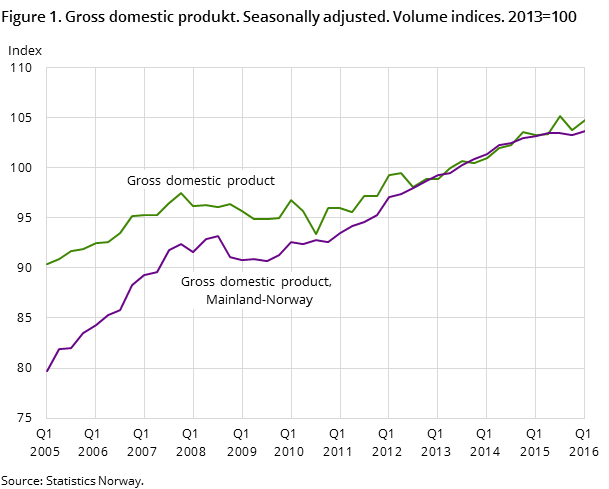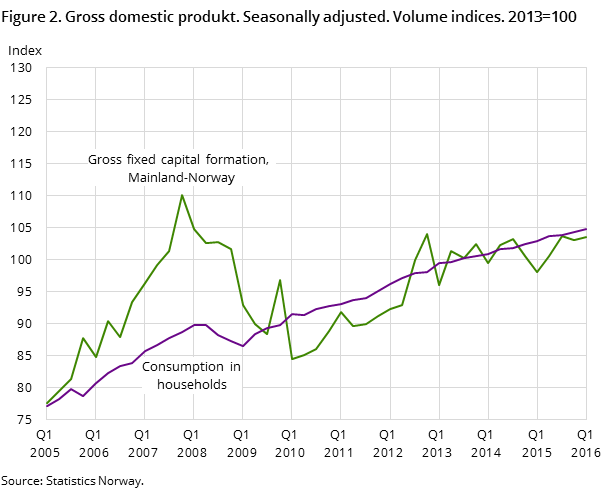Content
Published:
This is an archived release.
Weak GDP growth for Mainland Norway
According to seasonally-adjusted figures, gross domestic product (GDP) for Mainland Norway rose 0.3 per cent in the 1st quarter of 2016. In comparison, the 2nd half of last year showed a slight decrease. High electricity production was the main contributor to the growth.
| 2015 | 2nd quarter 2015 | 3rd quarter 2015 | 4th quarter 2015 | 1st quarter 2016 | |
|---|---|---|---|---|---|
| 1Figures from 2014 onwards are preliminary. | |||||
| Gross domestic product | 1.6 | 0.1 | 1.7 | -1.3 | 1.0 |
| Gross domestic product Mainland Norway | 1.0 | 0.2 | 0.0 | -0.1 | 0.3 |
| Petroleum activities and ocean transport | 3.8 | -0.3 | 8.0 | -5.5 | 3.3 |
| Final domestic use of goods and services | 0.6 | -0.3 | -1.3 | 0.3 | 1.5 |
| Final consumption expenditure of households and NPISH | 2.0 | 0.7 | 0.2 | 0.5 | 0.3 |
| Final consumption expenditure of general government | 1.9 | 0.3 | 0.5 | 0.4 | 0.9 |
| Gross fixed capital formation (GFCF) | -4.2 | 0.6 | 0.1 | -1.3 | -0.9 |
| Total exports | 3.4 | 0.8 | 6.0 | -3.5 | -1.2 |
| Total imports | 1.1 | -0.3 | -1.8 | 0.7 | -0.4 |
| Employed persons | 0.5 | 0.2 | 0.1 | -0.1 | 0.1 |
| Total hours worked | 0.6 | 0.1 | -0.1 | -0.2 | 0.1 |


The strong growth in electricity production was partly the result of a cold start to the year and partly due to record-high water levels in the reservoirs. Excluding production of electricity, GDP for Mainland Norway grew 0.1 per cent.
Value added in the manufacturing industry has shown a negative development since the autumn of 2014, but the decline has now slowed. For the manufacturing industry as a whole, the preliminary seasonally-adjusted figures show a 0.5 per cent decline in the 1st quarter. The decline was 1.5 per cent in the 4th quarter of last year. The weak trend in the oil-related manufacturing industries continues, but is not quite as broad as last year. Within the shipbuilding industry there are clear signs of improvement, with a shift towards other markets.
The construction industry has shown an increasingly positive trend, with a growth of 1.1 per cent in the 1st quarter. Within the land-based primary industries, growth in forestry pushed up volumes, while the offshore-based primary industries saw a clear upturn in traditional fishing and a decline in aquaculture. Last year's modest development in the service industries excluding general government continued, with a slight decline in the 1st quarter. The public sector, on the other hand, saw a clear growth in activity, with a volume increase in value added of 0.8 per cent, which is considerably higher than the average growth last year.
Value added in extraction as well as transport via pipelines of oil and gas grew in the first quarter and contributed to the rise in total GDP, which was up 1.0 per cent.
Weak growth in household consumption
After sluggish growth in the 3rd quarter and somewhat stronger growth in the 4th quarter of last year, household consumption continued to increase at a modest pace in the first quarter. One again it was consumption of services that increased, while consumption of goods was unchanged from the last quarter of 2014.
Consumption in general government grew 0.9 per cent in the 1st quarter. Local government and central government grew 0.7 and 1.0 per cent respectively.
Increased business investment
Total fixed capital formation decreased 0.9 per cent in 1st quarter of this year, thus continuing the trend from last year. For Mainland Norway, there was however a slight increase in investments. Investment activity picked up in a number of manufacturing industries, while last year's increase in investments in production of basic metals appears to have levelled off. Household investment in housing has risen steadily since late 2014 and increased 1.3 per cent in the 1st quarter of 2016. Public investments were lower in the 1st quarter compared to the 4th, partly as a result of the delivery of two combat aircraft last autumn.
Preliminary figures show that the decline in petroleum-related investments continued in the 1st quarter.
Reduced exports of traditional goods
Exports of goods and services as a whole decreased by 1.2 per cent in the 1st quarter of 2016. The volume of exports of traditional goods was 5.3 per cent lower than in the 4th quarter. The decline in the 1st quarter is mainly due to lower exports of refined oil products. The export volume of both oil and gas and of services increased, however, but not sufficiently to prevent an overall slowdown in the demand for exports.
Imports of traditional goods increased 0.2 per cent in the 1st quarter, after a slightly stronger growth in the previous quarter. Overall, imports of goods and services decreased by 0.4 per cent.
Higher employment
From the 4th to the 1st quarter, total employment increased 0.1 per cent. This amounts to about 4 100 persons. Number of hours worked increased by 0.1 per cent in the 1st quarter.
Figures 1 - Q4 2015 revised
In connection with the release of figures for the 1st quarter of 2016, all quarters in 2015 are revised. The new figures show a quarterly growth in GDP for Mainland Norway of 0.2, 0.2, 0.0 and -0.2 per cent respectively, which implies a downward revision in the 4th quarter.
An overview of the revisions in macroeconomic variables is given in Appendix Table no. 48.
For an overview of developments in the gross domestic product for some of our trading partners, see OECD’s statistics.
Main revision of the national accountsOpen and readClose
Statistics Norway has made a main revision to the national accounts. The first results from this revision were published on 20 November 2014. The revisions are partly due to new international recommendations on national accounting and partly the result of improved methods of estimations and new sources. Read more about the main revision here.
How the figures are calculatedOpen and readClose
The sum of four quarters in the Quarterly National Accounts (QNA) makes up the preliminary annual figures until the Annual National Accounts (ANA) for year t are published in November in year t+2 and incorporated as a new base year in the QNA. Hence, 2011 is the base year in the QNA when publishing data in May 2014.
In both the ANA and QNA, the figures stripped of movements in prices are referred to as volume changes, or fixed price estimates in the QNA, and this is done to identify the underlying cyclical pattern of the economy.
Note that in the time series in volume, the figures from the base year and onwards are fixed price figures, while data prior to the base year are chained volume figures. This implies that additivity in volume is lost prior to the base year.
Contact
-
Pål Sletten
E-mail: pal.sletten@ssb.no
tel.: (+47) 99 29 06 84
-
Ingunn Sagelvmo
E-mail: ingunn.sagelvmo@ssb.no
tel.: (+47) 40 90 26 32
-
Pia Tønjum
E-mail: pia.tonjum@ssb.no
tel.: (+47) 48 99 12 07
-
Kristian Gimming
E-mail: kristian.gimming@ssb.no
tel.: (+47) 91 88 39 06
